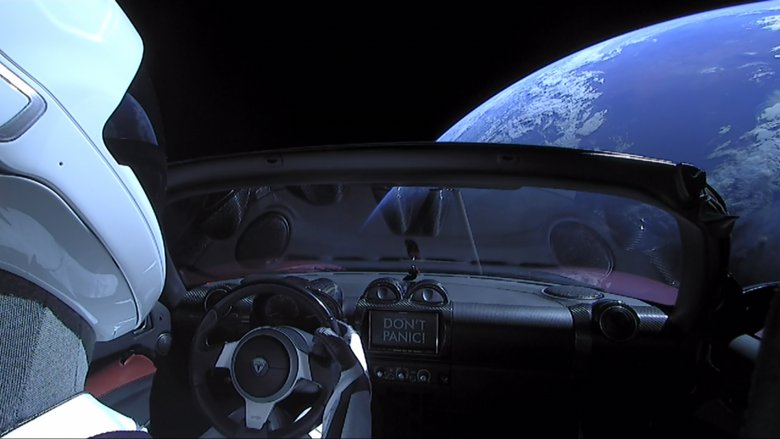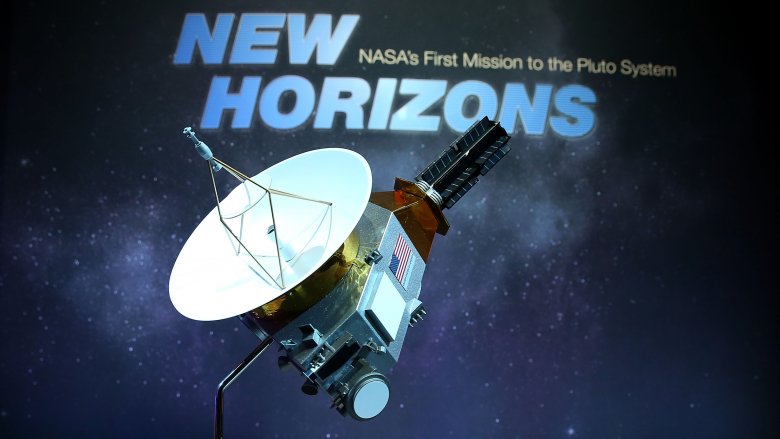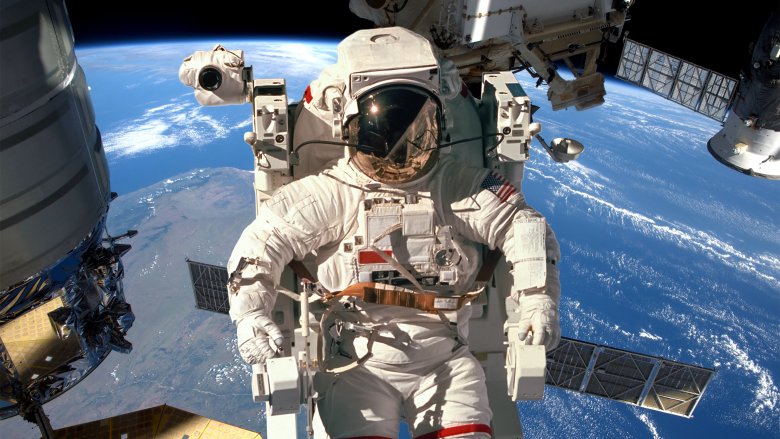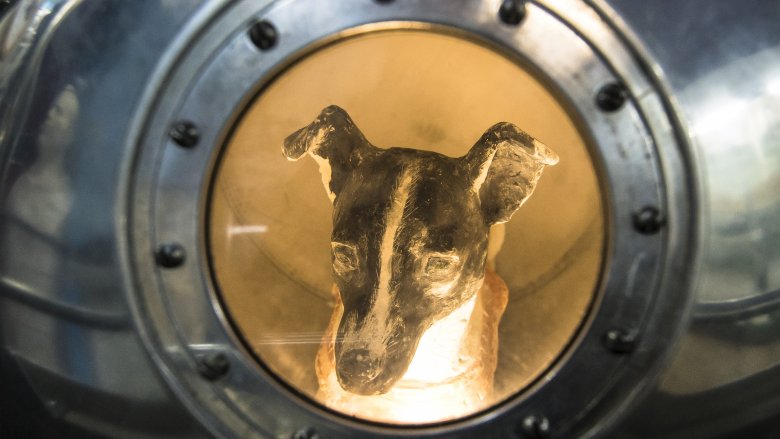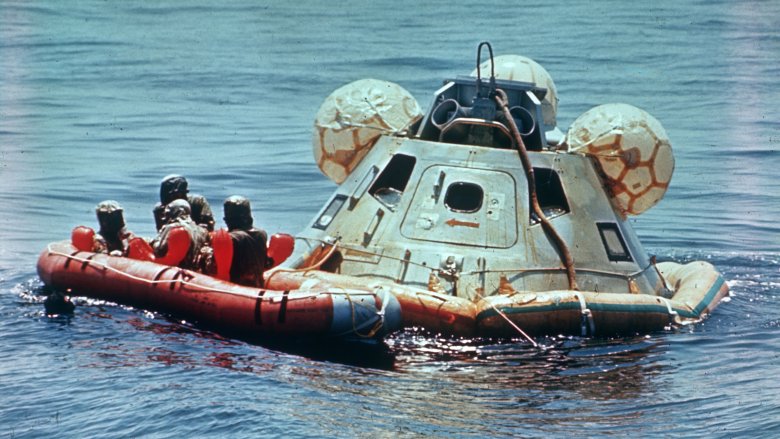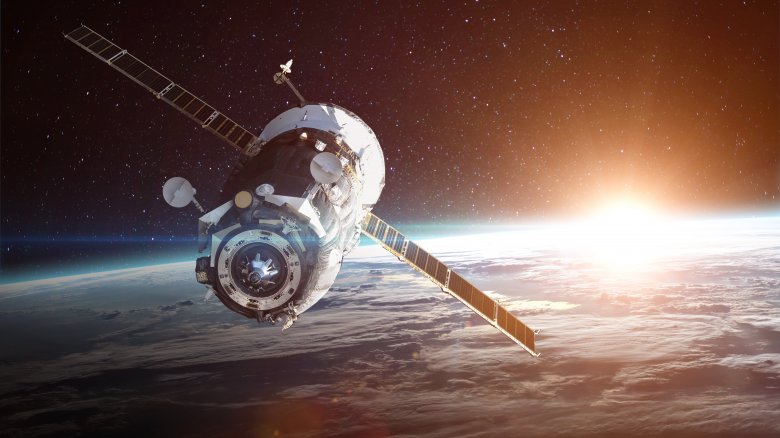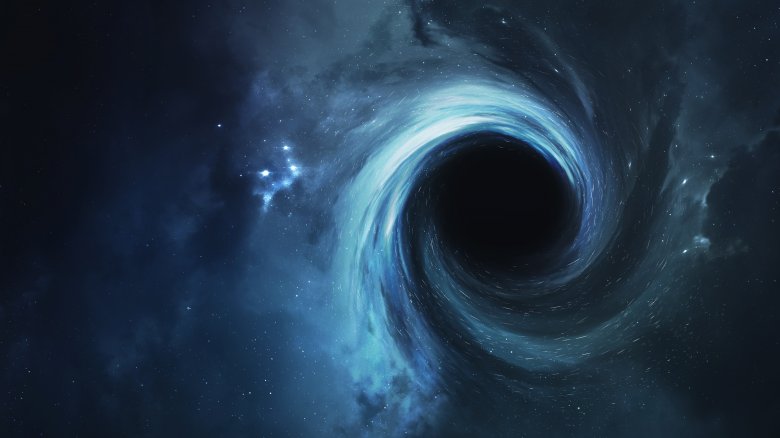Bizarre Things Floating In Space
Space, in the words of the not-entirely-immortal Douglas Adams, is big. Really big. It's so big, in fact, that you'd actually be forgiven for believing that pretty much all of it is completely empty — hence the name. It's true that, according to science, only 4 percent of it is made up of stuff. Now, most of that "stuff" tends be planets and galaxies and black holes and all manner of freaky-deaky cosmic shenanigans, but there's also room for some weirder things up there, too.
Yes, for every millionth planet floating out in space, there's also a dead dog. For every hundred thousandth galaxy, there's a record of hit music. And for every few black holes, there's a man who discovered Pluto. The fact is that, thanks to human meddling (it's what we do best!) there's a whole lot of really bizarre stuff floating out among the stars. This is only some of it.
Elon Musk's ride
This is one of space's newest residents. On February 6, 2018, SpaceX launched its Falcon Heavy rocket with a very special cargo on board: Elon Musk's Tesla Roadster. In a move The Atlantic dubbed "yet another shift in the American spaceflight business" but which everybody else dubbed "just a little bit nuts," the Tesla shot into the night sky attached to the upper stage of the rocket. The car is expected to begin orbiting the Sun before being gradually brought closer and closer to Mars. Considering the car is laden with bacteria, this might actually end up being something of a problem for the planet, should that bacteria make it to the planet's surface, where it could pose a threat to any biological life that might exist there.
Still, for now, it's at least a fun little gimmick on Musk's part, and you can even trace the car's orbit thanks to a nifty website set up shortly after the launch. Just try to ignore the whole "biothreat to life on Mars" bit.
The guy who discovered Pluto
Space burials aren't a particularly new phenomenon. The idea of blasting your remains (that'd be your ashes, unless you've really got resources) into the cosmos has been around for decades, beginning with Gene Roddenberry, creator of Star Trek, who became the first dead person to enter outer space when his ashes were taken aboard Columbia. Parts of Roddenberry's remains have gone up a few times since, but, every time, have actually either returned back safely to Earth or burned up in the atmosphere.
One person whose remains have actually gone where no man has gone before, however, is Clyde Tombaugh. Tombaugh was an American astronomer most famous for discovering Pluto in 1930, and, long after his death, his ashes were shot into space aboard the spacecraft New Horizons with the eventual hope that they'll successfully depart the solar system. Oh, while we're at it, there's also a guy buried on the Moon. Just so you're aware.
Urine crystals
All the movies and the books and the documentaries have such a way of making space flight so romantic, don't they? For them, it's all shimmering auroras and dawnbreak over Earth's horizon and somersaulting through space stations. But there's a dark side to the business, you know — a grim, grim dark side. You see, despite their propensity toward thrift and their insistence on recycling everything they can, eventually, spaceships have to jettison waste. Sometimes, this takes the form of a water dump. These dumps (which are often mistaken for shooting stars) eject urine and excess water out into the glorious cosmos, where it freezes into a cloud of miniscule ice droplets. After a while, the ice is melted by the Sun and turns into water vapor before floating off through space.
What this basically means is that, at any one moment during a major manned mission, there's likely to be a small mass of piss-cicles drifting listlessly across the night sky. And, statistically speaking, there's even a good chance someone saw them and made a wish.
One of America's sillier plans
The Cold War was a weird time. It was an era of madcap schemes, bizarre military innovations, and inexplicable competitions between East and West. Perhaps weirdest of all, however, is the time the USA attempted to remake the entire planet's ionosphere just to defend a weak point in America's communications systems. See, underwater cables (which were used for long-range communications) were vulnerable to attacks by the Soviets. Should the dirty Russians succeed in such an attack, America would be forced into communicating across the world with radio broadcasts. The problem there, though, is that the ionosphere, which allows such broadcasts, is often disrupted by solar activity.
The solution? Project West Ford. Millions and millions of tiny copper needless sent up into space to form a permanent radio reflector that would be invulnerable to attack from either the Soviets or the Sun. To cut a long story short, it didn't work, and most of the needless eventually burned up as they re-entered the atmosphere. Some thousands, however, are still up there, bunched together in clusters — a continuous cosmic monument to the sad truth that not every idea is a good idea.
Lots of dead animals
While human beings have traditionally hoovered up all the glory for their achievements in space exploration, we all too rarely show appreciation for the unsung heroes in the field: the ones who never made it home. Yes, before we saw fit to send astronauts up there, we saw fit instead to test out space's dangers by firing a few animals up. In 1947, a troupe of fruit flies successfully launched into space and safely returned to Earth. They were the lucky ones.
Next was Albert I, a rhesus monkey who died of suffocation during his flight. Albert II died on re-entry. The dog Laika, perhaps the most famous cosmic critter, died shortly after launch. Other countries continued to send up monkeys throughout the ensuing decades, with Iran even launching one up as recently as 2013. Some burned up as they came back down to Earth. Others are still up there, trapped inside their own floating tombs. Life as a fruit fly isn't looking so bad now, is it?
A giant boomerang
What's more impressive than a piece of space debris that is fired off into the far reaches of the solar system? A piece of space debris that comes back. This is what happened with one piece of the Apollo 12 rocket, part of the spacecraft that delivered Charles Conrad and Alan L. Bean to the Moon. After detaching from the spacecraft, this section of the rocket's engine drifted off into deep space and began to orbit the Sun. In the early 2000s, however, it returned, baffling scientists, who initially believed the object (which they designated J002E3) was an asteroid.
Eventually, it began to orbit the Earth itself and came close enough to the planet that it seriously threatened other satellites in the sky. Most likely, J002E3 will eventually either burn up in Earth's atmosphere or smash into the Moon. Either way, it'll be a fitting end to an extraordinary journey.
Niku, whatever that is
One of the most fascinating aspects of space's near-infinite size is that, sometimes, scientists discover something they simply cannot explain. Usually, however, they exist hundreds or thousands of lightyears away — not right on our doorstep. Enter Niku, a mysterious object on the edge of our solar system that has experts pretty much baffled. The defining feature of Niku is its retrograde orbit, a peculiar quirk which means it moves in the opposite direction of everything else in the system. It exists somewhere just beyond the orbit of Neptune and is accompanied by five other objects with similar characteristics which all orbit on the same plane.
Weirder still, research has suggested that they may have existed in these orbits for millions of years, and that there may be more objects in the sky acting in a similar manner. Just why they do so, and why they're all so tightly packed, is a total mystery.
A satellite that might just ruin everything
You saw Gravity, right? It's the one where Sandra Bullock talks to herself for ages, then briefly talks to George Clooney, then (spoiler alert) it turns out she was just talking to herself after all, and then there's a fire. Well, Gravity also depicts something called Kessler syndrome, a phenomenon in which one piece of space debris collides with another, which in turn collides with more debris, slowly creating a mass of killer junk that swallows up and knocks out anything in its path. And it's a real thing, too — experts have been worried about Kessler syndrome and its potentially devastating effects on Earth's global network for years. Some, such as engineer Charlotte Bewick and Donald Kessler himself, even believe it's already happening.
One of the biggest potential triggers for the effect is Envisat, an ESA satellite that was retired in 2013. Defunct and unable to be piloted, the massive satellite is essentially a time bomb, just waiting to collide with another piece of debris and trigger the chain reaction. A scheme known as e.Deorbit, which hopes to sweep up space debris (including Envisat), is currently on the cards, but just how successful it will be is unknown.
Johnny B. Goode
Perhaps one of the most famous space missions of all time, Voyager also happens to be one of the most far-reaching and impressive feats humanity has ever accomplished. In case you don't know, the concept is simple: two probes, Voyager 1 and Voyager 2, were sent out into the solar system to study the planets. After surpassing them, however, they now travel through deep space — Voyager 1 is currently in interstellar space and Voyager 2 is in the heliosheath, far beyond the edge of Pluto's orbit.
One of the most famous facets of the Voyager program is the Golden Record, a compilation of Earth music sent, with a number of other pieces of information, as part of a time capsule ready to be discovered by other spacefarers in the far future. Among the songs chosen for inclusion on the Golden Record are Bach's "Brandenburg Concerto No. 2," "Zaire" (an initiation song for pygmy girls), and Chuck Berry's "Johnny B. Goode."
Lots and lots and lots and lots of water
If you're a really great guesser, you might have expected to find a Chuck Berry record or a dead monkey floating through the far reaches of outer space. What you might never expect to find, however, is water — masses and masses of it. That's what happened in 2011, when two teams of astronomers came across the largest reservoir of water ever detected in the universe. It was roughly equivalent to 140 trillion times the water in all of Earth's oceans and surrounded a ridiculously huge black hole more than 12 billion light years away.
The black hole itself, known as a quasar, is 20 billion times the size of the Sun and produces as much energy as a thousand trillion of our Suns. Although astronomers had expected water to exist at these far distances and in such a capacity, they had never actually managed to observe it before the discovery.

